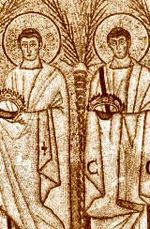St. Protus and St. Hyacinth
Today is the feast of St. Protus and St. Hyacinth. According to tradition, Protus and Hyacinth were brothers, and chamberlains to Saint Eugenia, the daughter of the governor of Egypt. They were baptized along with Eugenia by Helenus, Bishop of Heliopolis, which is near Cairo. Since her pagan father was a powerful government official, and very much opposed to her baptism, to avoid notice Eugenia had slipped out of her father's house disguised as a man.
Eventually, Eugenia's father converted to the Faith, became bishop of Alexandria and was martyred. Eugenia then moved to Rome, accompanied by Protus and Hyacinth. During the persecution of Emperor Valerian (reigned 257 AD –259 AD) Protus and Hyacinth were arrested, and, refusing to deny their faith, they were first scourged and then beheaded on September 11, 258. St. Eugenia would be martyred later that same year, on the feast of the Nativity. Eugenia had dreamt that she would be martyred on this feast, and her dream proved to be accurate.
There is a legend that after her baptism St. Eugenia went right on disguising herself as a man, and even became an abbot. According to the legend, while an abbot and still dressing like a man, St. Eugenia cured a woman of an illness. Perhaps from gratitude, or maybe because she found people who could cure illnesses irresistibly attractive, the woman made sexual advances, which St. Eugenia rebuffed. Not one to accept rebuff with grace, the woman publicly accused St. Eugenia of adultery. At the time, this was illegal, so St. Eugenia was taken to court, still dressed as a man, where she faced her judge, who, as luck would have it, was her father, the governor. St. Eugenia's female identity was revealed and she was exonerated.
St. Eugenia may have been forgotten by most Catholics, but she is recognised by the LGBT community as a "transgender saint." You may peruse a calendar of such saints here; Saints Hyacinth and Protus are also included on the calendar because, according to the calendar compiler, they were eunuchs. Even if Saints Hyacinth and Protus were eunuchs, it is unclear this would qualify them as transgender, varied and multifarious though the taxonomy of that type appears to be.
Though the lives of many early saints are surrounded by legends, some facts concerning St. Hyacinth and St. Protus can be established with certainty. According to the Depositio Martyrum, (ca. 336 AD), the most ancient listing of martyrs, St. Protus and St. Hyacinth were buried in the Cemeterium of Basilla on the Via Salaria, later named the Catacomb of St. Hermes. In 1845 a Jesuit priest discovered the still undisturbed grave of St. Hyacinth in this catacomb. It was a small square niche in which lay ashes and pieces of burned bone wrapped in the remains of costly fabric. Evidently the saint had been burnt; most probably both martyrs had suffered death by fire. The slab on the niche bore the original Latin inscription that confirmed the date in the Depositio Martyrum:
D P III IDUS SEPTEBR
YACINTHUS
MARTYR
(Buried on 11 September Hyacinthus Martyr).
The priest also found fragments of Protus's grave nearby.
"Battle of San Jacinto" Henry Arthur McArdle

.jpg/300px-The_Battle_of_San_Jacinto_(1895).jpg)
No comments:
Post a Comment